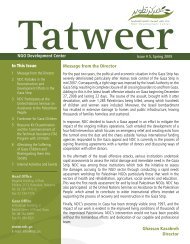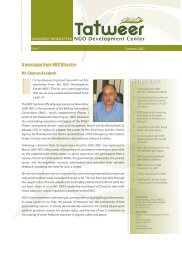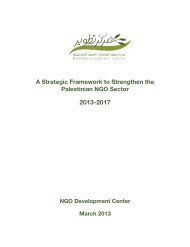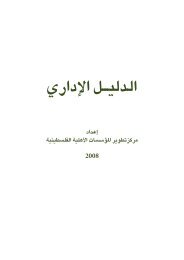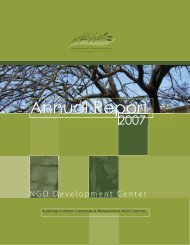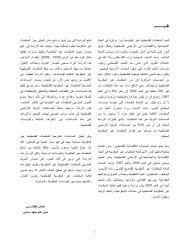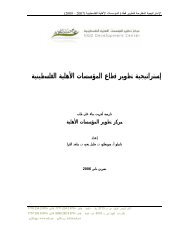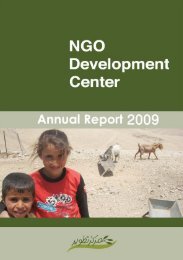Tracking External Donor Funding.pdf - NDC
Tracking External Donor Funding.pdf - NDC
Tracking External Donor Funding.pdf - NDC
You also want an ePaper? Increase the reach of your titles
YUMPU automatically turns print PDFs into web optimized ePapers that Google loves.
Figure 44: Percentage of <strong>External</strong>ly Funded PNGO<br />
Activities by Target Population and Period<br />
100%<br />
90%<br />
80%<br />
70%<br />
60%<br />
50%<br />
40%<br />
30%<br />
20%<br />
10%<br />
0%<br />
1999-2000 2001-2005 2006-2008<br />
Urban Rural Refugee All<br />
Source: MAS, 2009 – PNGO Survey<br />
Refugee target groups receive only a fraction of the total<br />
external aid to large PNGOs, with the highest percentage<br />
(11%) being in the second period.<br />
The high percentage of respondents choosing the ‘All<br />
Populations’ category is reflective of a sample weighted<br />
towards large PNGOs working at the national and seminational<br />
levels. We suspect however that the lower<br />
percentage of external funded PNGO activities targeting<br />
‘all populations’ in the third period, reflects the better<br />
record keeping of PNGOs in more recent years, allowing<br />
them to better allocate their activities by target<br />
population.<br />
3.11.3 Location of Large PNGO Project<br />
Implementation by Region and Period<br />
Our PNGO survey aimed to capture the changes in the<br />
geographic distribution of large PNGO project<br />
implementation on the regional level over the three<br />
periods of time, rather than the population of PNGOs as<br />
a whole. As the following table shows, there is a slight<br />
increase (12.4% to 14.8%) in large PNGO activity in the<br />
North WB during the second period, when the region<br />
underwent extreme economic and social destruction in<br />
Israel’s operation “Defensive Shield”. In the third period,<br />
the percentage returns to little over twelve, highlighting<br />
that within the West Bank, the north is the most under<br />
represented region in comparison to the population<br />
(24.3%).<br />
The Central WB sees a slight increase between the first<br />
and second periods, before declining again in the third<br />
period to around 11% of the total. As the Central WB<br />
constitutes 17.8% of the total Palestinian population, it<br />
could be viewed as under represented in terms of<br />
externally funded PNGO activities. However, we believe<br />
this to be untrue as a number of the organizations<br />
working at the All Palestine levels are located in the<br />
Central WB and carry out activities there, as well as the<br />
rest of the WB&GS.<br />
The distribution of externally funded PNGO activities in<br />
the South WB increases steadily over the three periods,<br />
from 14.8% to 18.9%. This is precisely the distribution<br />
of the population in the region.<br />
The Gaza Strip is home to 39% of the Palestinian<br />
population in the WB&GS and 29% of its activities. Like<br />
the other regions, the Gaza Strip does receive a portion<br />
of the aid designated as ‘All Palestine’.<br />
60


